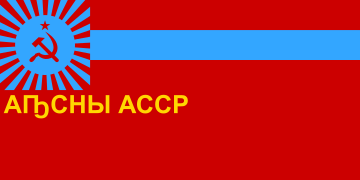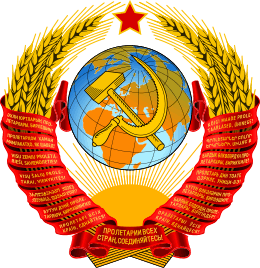Abkhaz Autonomous Soviet Socialist Republic
The Abkhaz Autonomous Soviet Socialist Republic (Russian: Абхазская Автономная Советская Социалистическая Республика; Georgian: აფხაზეთის ავტონომიური საბჭოთა სოციალისტური რესპუბლიკა; Abkhazian: Аҧснытәи Автономтә Советтә Социалисттә Республика), abbreviated as Abkhaz ASSR (Russian: Абхазская АССР; Georgian: აფხაზეთის ასსრ; Abkhazian: Аҧснытәи АССР), was an autonomous republic of the Soviet Union within the Georgian SSR. It came into existence in February 1931, when the Socialist Soviet Republic of Abkhazia (SSR Abkhazia or SSRA), originally created in March 1921, was transformed to the status of Autonomous Soviet Socialist Republic within the Georgian SSR.
| Abkhaz Autonomous Soviet Socialist Republic | |||||||||||
|---|---|---|---|---|---|---|---|---|---|---|---|
| Autonomous republic of the Georgian SSR | |||||||||||
| 1931–1996 | |||||||||||
 Flag
.svg.png) Coat of arms
| |||||||||||
| Capital | Sukhumi | ||||||||||
| Area | |||||||||||
• | 8,600 km2 (3,300 sq mi) | ||||||||||
| Government | |||||||||||
| • Type | Autonomous Soviet Socialist Republic | ||||||||||
| • Motto | "Пролетарии всех стран, соединяйтесь!" | ||||||||||
| History | |||||||||||
• Established | 19 February 1931 | ||||||||||
• Disestablished | 30 November 1996 | ||||||||||
| |||||||||||
The Abkhaz ASSR adopted its own constitution on 2 August 1937. The supreme organ of legislative power was the Supreme Soviet elected every 4 years and its Presidium. The executive power was vested with the Council of Ministers appointed by the Supreme Soviet. The Abkhaz ASSR had 11 representatives in the Council of Nationalities of the Supreme Soviet of the USSR.
History
Formation
The Socialist Soviet Republic of Abkhazia (SSR Abkhazia) had been established in 1921 after the Red Army invaded Georgia. The SSR Abkhazia, which was united with the Georgian SSR later that year as a "treaty republic," existed until 1931. During this time it was granted considerable amounts of autonomy, by virtue of its unique status in relation to Georgia. However this concerned the Soviet and Georgian authorities, and it was reduced to that of other autonomous republics.[1] So on 19 February 1931 the SSR Abkhazia was reformed as the Abkhaz Autonomous Soviet Socialist Republic, wholly under the control of Georgia, which itself was a constituent republic of the Transcaucasian Socialist Federative Soviet Republic (TSFSR).[2]
The downgrading of Abkhazia was not a popular one amongst the Abkhaz population. The SSR Abkhazia had a considerable degree of autonomy, including its own national symbols (a flag and coat-of-arms), and national army units, a right only given to full republics.[3] It also had its own constitution, another right only granted to full republics.[4] When it was reformed into the Abkhaz SSR protests broke out in the region, the first time large-scale protests against the Soviet authorities had occurred there.[5]
Dissolution
The advent of perestroika allowed the Abkhaz an outlet to express their dissatisfaction of their status within Georgia. In 1988 a letter, signed by leading Abkhazians, was forwarded to Mikhail Gorbachev and the Soviet leadership. It outlined the grievances the Abkhaz felt and argued that despite the concessions of 1978, autonomy had largely been ignored in the region. It concluded by asking for Abkhazia to be removed from the Georgian SSR, and it to be restored as a full Soviet republic, akin to the SSR Abkhazia.[6] This was followed in March 1989 with the Lykhny Declaration, which was a document signed by some 37,000 people.[7] This led to protests in Georgia, which culminated into a massive major anti-Soviet and pro-Georgian independence rally in Tbilisi on 9 April 1989, which was violently dispersed by Soviet Interior Ministry troops, resulting in the deaths of twenty, mostly young women, and the injury of hundreds of demonstrators.[8] The 9 April tragedy removed the last vestiges of credibility from the Soviet regime in Georgia and pushed many Georgians into radical opposition to the Soviet Union, and exacerbated ethnic tensions between Georgians and other groups, in particular the Abkhaz and Ossetians.[9] Further riots in Sukhumi opposing the establishment of a branch of the Tbilisi State University exacerbated Abkhaz nationalism.[10]
Tensions remained high in Abkhazia and saw the Abkhaz totally disregard Georgian authority in the region. This was confirmed on 25 August 1990, when the Abkhaz Supreme Soviet passed a declaration, "On Abkhazia's State Sovereignty," which gave supremacy to Abkhaz laws over Georgian ones.[10] The Supreme Soviet also declared Abkhazia to be a full union republic within the Soviet Union.[11]
The victory of a nationalist coalition in October 1990 only further led to increased issues, as the newly elected Chairman of the Georgian Supreme Soviet, Zviad Gamsakhurdia, was outspoken in his desire to reduce the autonomy of the non-Georgian population in the country.[12] By this point, however, Georgian authority had effectively ceased in Abkhazia: Abkhazia took part in the Soviet referendum on 17 March 1991, which the rest of Georgia boycotted, while the non-Georgian population of the region (along with South Ossetia, another autonomous region of Georgia), in turn boycotted the referendum on independence on 9 April 1991.[13][14]
A power-sharing deal was agreed upon in August 1991, dividing electoral districts by ethnicity, with the 1991 elections held under this format, though it did not last.[11] However, with the breakdown of the Gamsakhurida government in Georgia, and efforts by Eduard Shevardnadze to delegitimize Gamsakhurdia by failing to honour agreements he signed, and Abkhaz desires to utilize the ongoing Georgian Civil War, it fell apart.[15] Thus on 23 July 1992, the Abkhaz Supreme Soviet re-instated the 1925 constitution, which had called Abkhazia a sovereign state, albeit one in treaty union with Georgia.[16] Georgia responded militarily on 14 August, starting a war that would last until September 1993, and further lead to the ongoing Abkhaz–Georgian conflict.[17]
Culture
Language
The Abkhaz language had seen multiple changes in script during the Soviet era. Under korenizatsiia the Abkhaz were not considered one of the "advanced" peoples in the USSR, and thus saw an increased focus on their national language and cultural development.[18] As part of these policies, Abkhaz was Latinized in 1928, along with many other regional languages in the USSR, moving from the original Cyrillic-based script in the process.[19] This policy was reversed in 1938, with Cyrillic replacing most of the Latin alphabets. Abkhaz was one of the few exceptions; along with Ossetian in the South Ossetian Autonomous Oblast (also of the Georgian SSR), it adopted a Georgian script, which lasted until 1953 when it reverted to Cyrillic (Ossetian did the same).[20]
See also
- First Secretary of the Abkhaz Communist Party
Notes
- Saparov 2015, p. 60
- Blauvelt 2007, p. 212
- Saparov 2015, pp. 50–56
- Saparov 2015, p. 62
- Lakoba 1995, p. 99
- Hewitt 1996, p. 202
- Francis 2011, p. 73
- Jones 2013, pp. 31–32
- Rayfield 2012, pp. 378–380
- Jones 2013, p. 44
- Zürcher 2005, p. 95
- Suny 1994, p. 325
- Francis 2011, p. 75
- Zürcher 2005, p. 93
- Zürcher 2005, pp. 95–96
- Chervonnaya 1994, p. 112
- Rayfield 2012, pp. 383–384
- Martin 2001, pp. 23–24
- Jones 1988, p. 617
- Broers 2009, pp. 109–110
Bibliography
- Anchabadze, Yu. D.; Argun, Yu. G. (2012), Абхазы (Abkhazians) (in Russian), Moscow: Nauka
- Blauvelt, Timothy (May 2007), "Abkhazia: Patronage and Power in the Stalin Era", Nationalities Papers, 35 (2): 203–232, doi:10.1080/00905990701254318
- Broers, Laurence (June 2009), "'David and Goliath' and 'Georgians in the Kremlin': a post-colonial perspective on conflict in post-Soviet Georgia", Central Asian Survey, 28 (2): 99–118, doi:10.1080/02634930903034096
- Chervonnaya, Svetlana (1994), Conflict in the Caucasus: Georgia, Abkhazia and the Russian Shadow, translated by Ariane Chanturia, Glastonbury, United Kingdom: Gothic Image Publications, ISBN 978-0-90-636230-3
- Francis, Céline (2011), Conflict Resolution and Status: The Case of Georgia and Abkhazia (1989–2008), Brussels: VUB Press, ISBN 978-90-5487-899-5
- Hewitt, B.G (1996), "The Georgian/South Ossetian territorial and boundary dispute", in Wright, John F.R.; Goldenberg, Suzanne; Schofield, Richard (eds.), Transcaucasian Boundaries, London: UCL Press Limited, pp. 190–225, ISBN 1-85728-234-5
- Hewitt, George, ed. (1998), The Abkhazians: A Handbook, New York City: St. Martin's Press
- Jones, Stephen (2013), Georgia:A Political History Since Independence, London: I.B. Taurus, ISBN 978-1-78453-085-3
- Lakoba, Stanislav (1995), "Abkhazia is Abkhazia", Central Asian Survey, 14 (1): 97–105, doi:10.1080/02634939508400893
- Lakoba, Stanislav (1990), Очерки Политической Истории Абхазии (Essays on the Political History of Abkhazia) (in Russian), Sukhumi, Abkhazia: Alashara
- Lakoba, Stanislav (2001), "Я Коба а ты Лакоба (I am Koba and you are Lakoba", in Iskander, Fasil (ed.), Мое сердце в горах: очерки о современной Абхазии (My heart is in the mountains: Essays on modern Abkhazia) (in Russian), Yoshkar Ola: Izd-vo Mariskogo Poligrafkombinata
- Rayfield, Donald (2012), Edge of Empires: A History of Georgia, London: Reaktion Books, ISBN 978-1-78-023030-6
- Saparov, Arsène (2015), From Conflict to Autonomy in the Caucasus: The Soviet Union and the making of Abkhazia, South Ossetia and Nagorno Karabakh, New York City: Routledge
- Suny, Ronald Grigor (1994), The Making of the Georgian Nation (Second ed.), Bloomington, Indiana: Indiana University Press
- Zürcher, Christoph (2007), The Post-Soviet Wars: Rebellion, Ethnic Conflict, and Nationhood in the Caucasus, New York City: New York University Press
External links
- "Abkhaz Autonomous Soviet Socialist Republic", Big Soviet Encyclopedia (in Russian).
Part of a series on the |
|---|
| History of Abkhazia |
|
19th century to 1921
|
|
Soviet era |
|
Contemporary era |
| Abkhazia portal |
